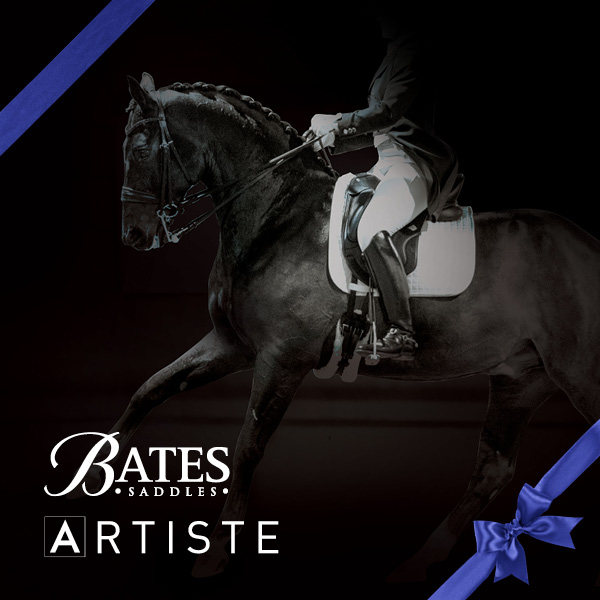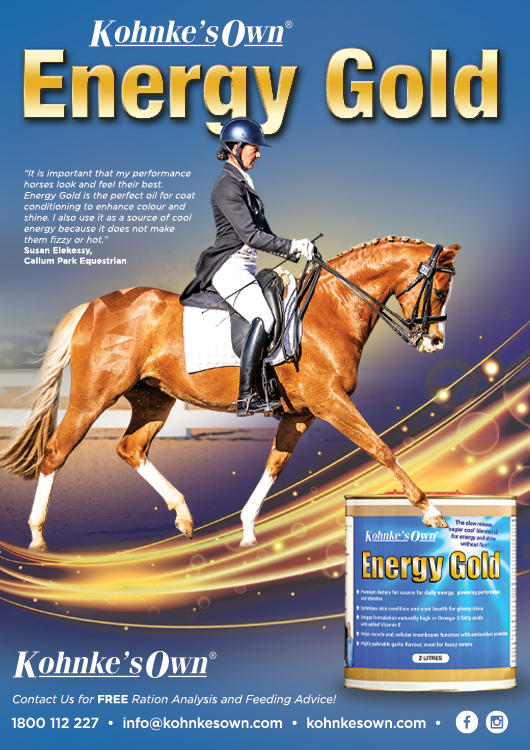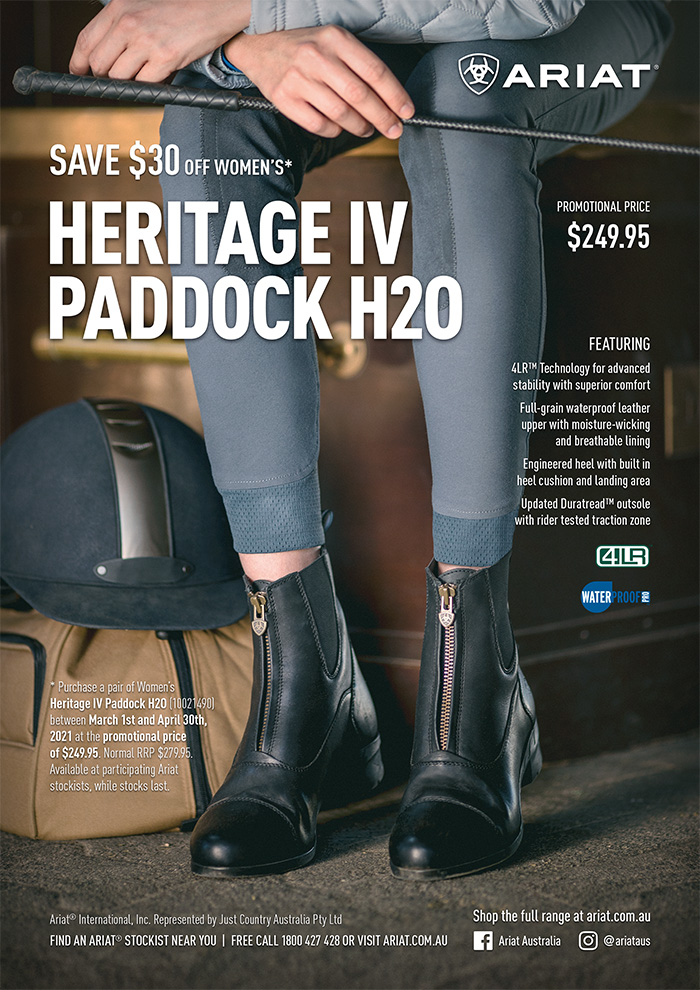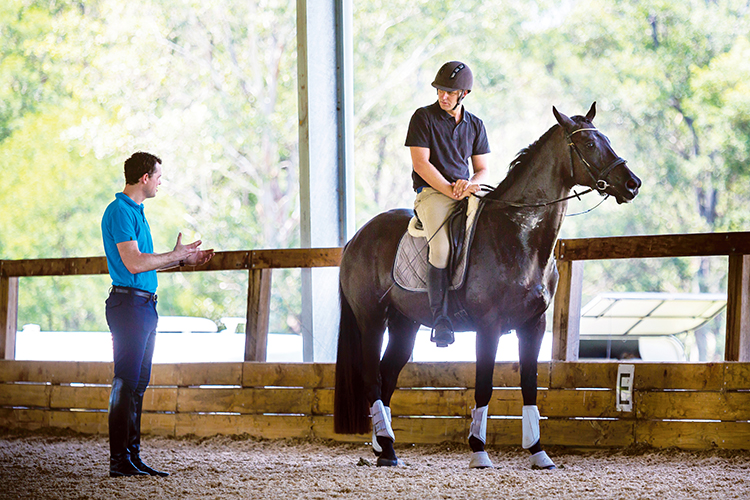 Story and photos by Rebecca Ashton
Story and photos by Rebecca Ashton
Good contact – Stefan Wolff tells us it’s essential, and how to achieve it.
Gail Benson wanted to work on contact issues with her Gracefield Stefan as she frequently gets the comment from judges that her reins are too long. Stefan worked on the connection of the horse and also the horse’s agility within a frame. “I know you can flick his head up but that doesn’t last. Work on forward and back, getting the hind end active and up to the bit. It doesn’t need to be extreme, but there needs to be a reaction from the horse and the outline maintained. You can half halt throughout your test to maintain the picture, not to change it.”
The half halt should not be a backward experience: “Not faster, just more agile. He needs to respond to the driving aid in the half halt… eventually the horse should offer collection and all you have to do is make use of it. You want the horse to offer more activity and you have the choice to take it or leave it. He’s obedient when you ask, but you want him offering it.”
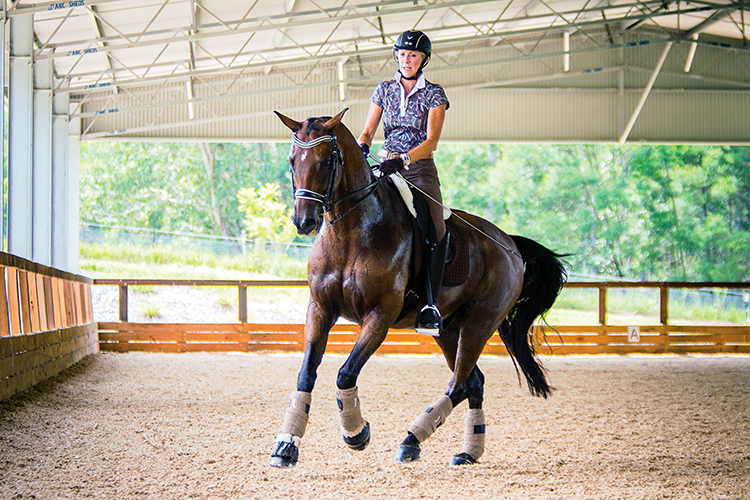 Gail Benson and Gracefield Stefan
Gail Benson and Gracefield Stefan
“You improve the shoulder in by improving the bend. Less angle to the wall but fix the flexion. The body is actually quite good. The bend follows all the way to his ears but then it stops. You can flex but don’t hold it, let it go all the way through let the horse move back toward the bit. Even when the horse’s body is bent, have the feeling that the haunches are working up to the bridle. There’s a big, big difference between leg yield and shoulder in.”
Up into canter: “Put your leg on and increase the number of strides, rather than have the horse longer or shorter. Fire him up, increase the activity without the horse running off, get a little more balance in the horse’s body, getting him to use the outside of his body more by riding from the inside leg to the outside rein.”
more follows
“We can never bring the horse back without activating it. You have to use your leg. Next time add another 20%. Don’t ride out of the half halt so much. Ride in and leave him there. Remember you’re looking for a response to the rein, not just a pull back. People think if they ask for more collection it’s harder for the horse, but in fact the opposite is true if you ask properly.”
“Go beyond the formalities required in the test. If you just do that then you only get a 5. Analyse it more.” 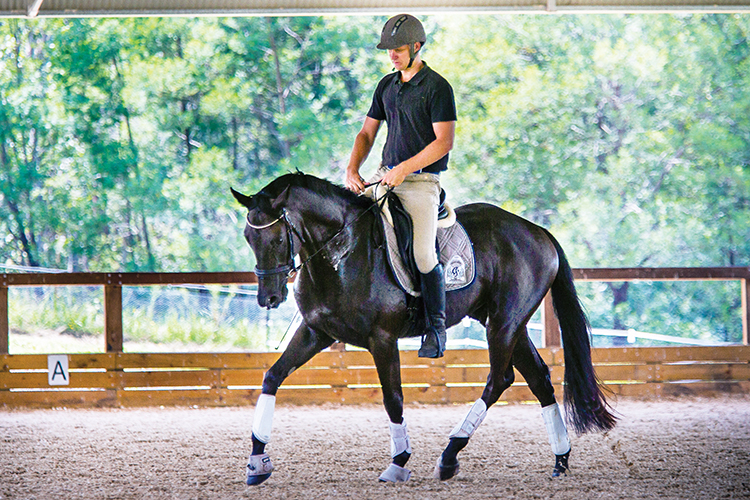
Craig Weeding on Statford Mandela
The next rider Craig Weeding on one of Lesley-Ann Taylor’s youngsters, Statford Mandela.
Stefan assessed, “This horse, not lower. Get him to stretch the neck out more. This one you need to ride up hill more. Wait for him. Give when he tells you to give. Push him a little into the bit before you give, so he learns to develop the neck and he doesn’t brace the neck. You must yield to his stretching desire. Then the back can stretch and work. You want a reaction forward but you don’t want to ride him too hard forward. Support with your leg. You almost have to feed the stretch.”
“There’s a difference between steering and turning. Don’t just pull the nose around. Ride him on a looped rein at the walk if he’s safe enough. Encourage natural strengthening of the walk without creating any rhythm issues.”
Back to the trot and encouraging a lengthened neck with good contact, “Hands together and upright. It looks more elegant, but also limits how much you can pull back! Your hand has to be always trying to sense if the neck is bracing, or trying to stretch, so it’s consistently ready to do any of the necessary aids. Then the leg is the producer. The hand is reactive.”
“You want the horse strong enough so he can hold his head in the correct position. Lengthen the rein so that you still get the same feeling on the rein. You want him to lengthen the neck not go lower. It’s a totally different group of muscles. Not too long but with the proper contact. That’s a work in progress. There’s no use lengthening the rein then pulling your hand back. Wait for him. Take your time. Ride on the longer rein, then shorter rein, longer, shorter so you work the muscle.”
The message was one of correct contact and getting the horse to seek the bit, even at this young age.
more follows

Alison Castle and Statford Rafaella
With Alison Castle and Statford Rafaella, the theme remained the same; contact, as well as getting the horse responsive and active without too much forward movement. “Reins shorter, but hands a little more out in front of you. Trot strides shorter, but a little bit quicker. Lighter with the hand. See, at the walk when you stimulate her, she doesn’t run forward, she’s actually coming back, but gets quicker. Now try and do that in the trot. Don’t be afraid to do a shorter stride. We’re always trying to get this big, competition trot, but not bringing them back shorter. Then they don’t need your support and you can leave the horse alone for a bit.”
“Hand low. Leg, tact, tact, tact, let her come up into the bridle. The lower the hand, the better the horse can be up in front of you. The half halt does not have anything to do with coming backward, think forward in it. Get reaction from the leg and see that it develops into a better contact. When she goes out with the nose it’s better to go with the flow a stride and then put her together again so you don’t hold her. Don’t drive every stride, get her to react better from the leg, and it to make it easier for herself. Your whole body language has to speak forward.”
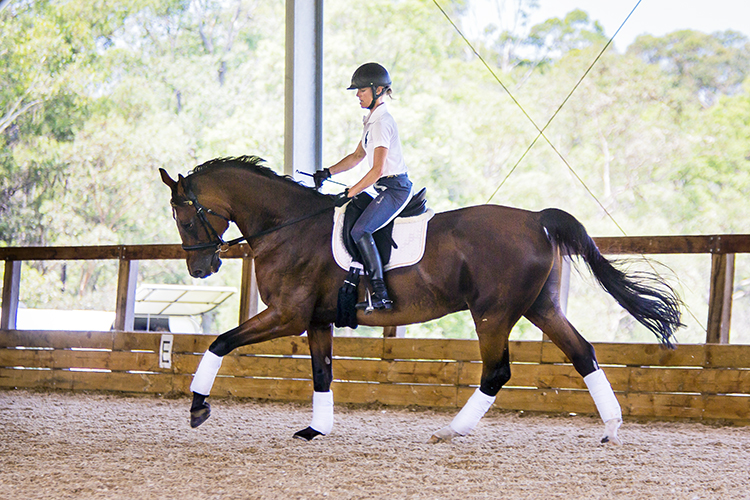
Eva Rasmussen and Rubellious
Eva Rasmussen was having problems with Rubellious who was very tight and strong in the neck.
Stefan got straight to the point, “Well then supple him! Flex him, just a little, but then ride him toward the inside rein. When a horse is against the bit, you ride forward into the bridle. Keep a steady hand, don’t move the hand, but keep the flexion. You need a stable contact with horses that a strong in the neck. You have to ride them firmer so they have a reason to give. Set your horse then let the horse deal with it and give him time to adjust. If you keep moving, what can he do? He doesn’t have time to adjust before you change the aid again. Flexion on the inside, steady and then ride toward the bit. Keep the bit in place.”
“If you stop driving the back stops working. You don’t drive to make it faster, you drive to improve the dynamics.”
“Tempo, activity, flexion. All the dynamics should work through the neck and come together in the poll and bit. All the movement of that big body gets tunnelled through the little poll. That’s the important thing. That is why moving the nose left and right doesn’t help because if the target, that is the poll, keeps moving, you can never get the energy through.”
“So now you have him on the bit, but not through the neck. You have to give with the hand so that he can go through the neck but not so much that he gets away from you. The giving is just to let the energy through. Give him a little finger, not your entire arm.”
Eva had to be careful not to do too much with the hand and instead of struggling to get the horse through the neck, do something entirely different, like walk, to deal with the problem so there was no struggle. “Horses try to find the easiest way of going which natural. You have to close down those ways.
“Keep riding! Don’t be in neutral. Don’t hesitate when he’s looking at something. The best way to keep his attention is keep your presence up. Give him something to do. Always push when you feel some resistance in the bridle.”
more feels

Brett Peel and the four-year-old Geordie Boy
Stefan: “He’s pretty good on the bit, but see if you can yield to it sometimes. Invite him to stretch the neck. Don’t give too early, but when it’s time to give, don’t ignore it. Your hand needs to always be sensing what’s going on, non-yielding when the horse is against you, but follow when he wants to stretch. Don’t worry so much about the low, worry more about the long.
“Pick him up just so you have contact, then use the leg, then follow when he gives. Have a leg that is not endlessly pressing him forward, but is improving the contact. If he stops stretching half way through the stretch, your hand should hesitate as well, ask more from behind and then give again.”
“Stretch forward, even uphill sometimes, not down. Follow the line of the crest. That’s the direction he should stretch.”
“You drive from behind and the horse pushes forward into the long rein. Give to him, but don’t let it get lighter. The better the horse is trained, the better the rider gives into the rein and not the other way around. The horse has to learn to place the rider’s hand. Give the rein forward and see where he takes you. Listen to your horse.”
“The next step is to realise is that it’s not just to keep the horse on the bit but to get the horse reaching for the bit. If you can teach the horse that you can probably teach it anything. That is the thing that most combinations have trouble with, especially at the high levels. It seems like a small detail now, but really it is not.”
Next Stephan asked Brett to ride a turn on the haunches: “He should be on the outside rein, but the balance should go to the inside. Make sure he is stretching and then ride out. The important thing at the moment is not that it’s small but more that you can keep operating up there. Next time, if you feel him come behind the leg, just ride straight out, prepare and ride another one. Most important is that he keeps accepting your aids and that he isn’t just doing the whole movement any way he can. If it’s just one stride for now, then that’s what it is.”
“All your aids are focusing on that you touch him with the aids and you get a response. You’re not chasing him away. You get a reaction and then you can relax, check your position, sit perfect, smile at the crowds! Relax your face like you have nothing else to do. Exactly!”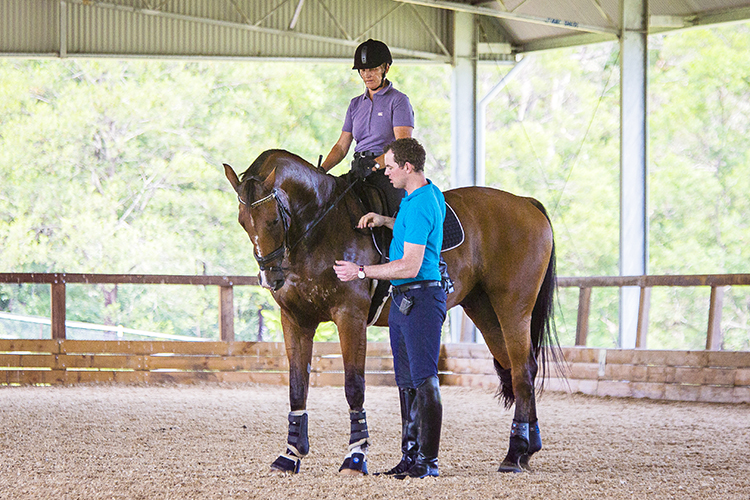
Sheree Neilson and Forest, a big baby
“Proper steady contact is more important than the stretch. If it changes every stride you cannot even call it a contact.”
“You are giving before you even have a contact. It has to be measurable – that’s why it’s called contact. When he moves the head around it is because he is not on the aids. Place the bit and let the horse come onto it. If you’re giving too much you’re not placing it.”
“Drive him onto the bit and let your hand wait. Low hands, no fiddling, no helping out. Drive. No flexing. You’re doing too much. Put the bit in one place and make sure he’s dealing with it from behind.”
“Before you worry about long and deep and flexion, you have to have steady contact. Before that you cannot even use your aids.”
“Steer him like a boat with the rudder in the back, not from the front like a steering wheel in a car…”
Stefan had Sheree riding with one hand, and it worked! “That is contact. Keep the hand in the middle of the wither. Don’t try and help him. Let him deal with things. Let him muddle around a bit.”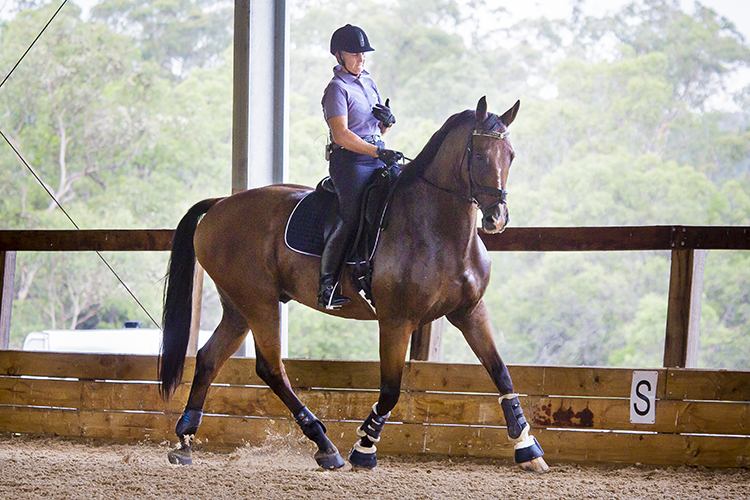
Sheree rides one handed
“You can interfere as much as you want with the leg, but not with the rein. The rein should be boring. The hands should be constant on either side of the neck so the neck can stabilise. The leg should tighten the rein. Work on the leg producing contact. That’s the whole point of it; riding from behind to the bit. The hand is just the counterpart to the leg. It doesn’t produce anything.”
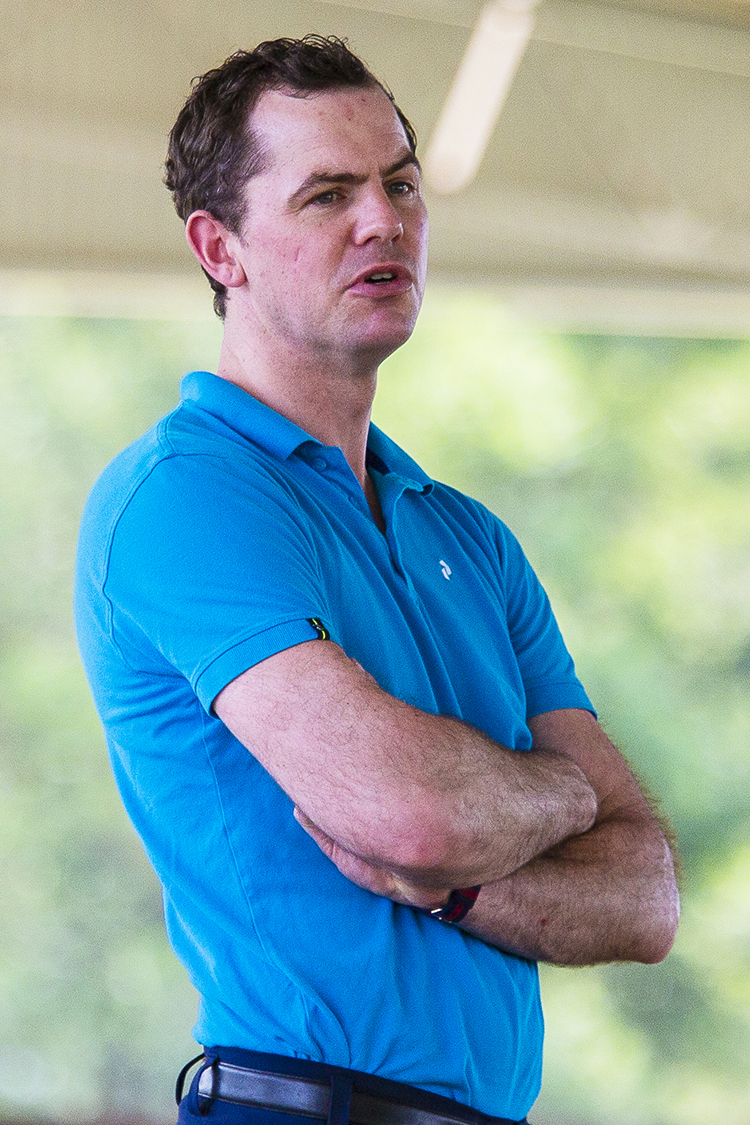 Rebecca sat down with Stefan after the clinic
Rebecca sat down with Stefan after the clinic
I know you touched on it a bit in our interview last year, but it seemed like contact was a major issue during this clinic…
“It is fact, in the contact you see every strength or weakness of the horse being worked. You see the entire training scale in the quality of the contact. You see rhythm faults by uneven contact, you see suppleness problems, straightness, tilting, lack of or too much impulsion, against the bit or behind the bit, connection issues. So contact is the ultimate measurement of the quality of the state of thoroughness.”
Do you think we understand it here?
“I would not use the term ‘here’. It is not a national problem of Australia. It is a challenge for everyone. If you talk about contact issues, you talk about thoroughness issues. Everyone has that. I do find a few people get a bit lost in detail. Let’s say, someone who wants to ride their horse long and deep, wants to do something good, fiddles around so much that they lose all contact, but the head is down. Then here riding on the long rein is of no benefit to the horse because there is no connection over the back. The neck is down but the back is gone so there is no connection so it’s useless.”
Are there other training issues that might be useful to point out to riders?
“One thing, from the very basic riding to the top it’s always again the rider’s ability to ride the horse from behind through the body, through to the bit. It is always again a struggle. That’s the art of riding. Look at the really fabulous riders, you don’t think much about it because the contact is there. You can always take it back to the driving aid, some connection problem to the head. Back to basics!”
We seem to be plateauing up at the high 60s low 70s in our dressage scores here in Australia. Do you have any tips how we can get through that level?
“Let’s say Germany, for example, has a huge advantage that we have such a high density of trainers, horse people, last generation horse people, institutions and short distances to get to them. For instance, if you want to have a weekend seminar in Germany, no matter which weekend you pick, get in your car and drive. Within 30 minutes to a maximum of four hours, you are there. So, I think the problem is more exposure to knowledge, looking at different riders, being around good riding, listening to good riding, seeing good riding. That all helps to boost your skills.”
“Obviously with a large country like Australia where there are good trainers, but they are spread out and there are fewer than at home, fewer weekend seminars and fewer knowledgeable people who may not be in the saddle, but on the ground, whatever. The exposure is not as dense as at home. I think that is what has the greatest impact. I don’t think it has anything to do with talent.”
Focusing on your lecture tonight, do you think flying changes very personalised?
“Generally I agree with that because generally it is reaction based and things are so quick and so refined that I do agree that changes are pretty much customised. But, it is not about whether I can do a change or not. I think a properly trained horse that can do a change when you apply the aid, even if it’s not exactly a customised aid, should do the change. I’m talking about the refined things like tempi changes where you might need a few rides to get with a particular horse. When I try horses with clients, when they have problems with the first change, it would never worry me or back me off buying a horse, for example, not when the horse showed under the usual rider that it can do changes.”
You talked about breaking the stride in the changes and ending up with a four beat canter. You see a lot of photos now with these horses with big canters and they’re not truly three beat. Do you think that’s just better technology that we can see it or the breeding or training or tension?
“No, I think the breeding has advanced no question. The horses get better. I’m living in the present, I don’t know what it was like in the past. Some of the older trainers say it was better before. Some say not. I don’t know if it has changed so much. People look more, you are right, with the media there are more pictures taken, more video, so that certainly means people look harder than before and analyse more than before.”
“But of course, it’s not a secret, some trainers use tension to make things more expressive and that’s turning into a system of riding. It’s not just that on the day you use a little bit of tension to prop up the horse. That wouldn’t be a problem. But the entire training system of a few trainers is based on producing tension and that is the problem.”
“Now, why do the trainers feel that they have to do it? Well there’s obvious reasons, pressure from the clients, money, fame, all those things. But certainly it’s not a secret.”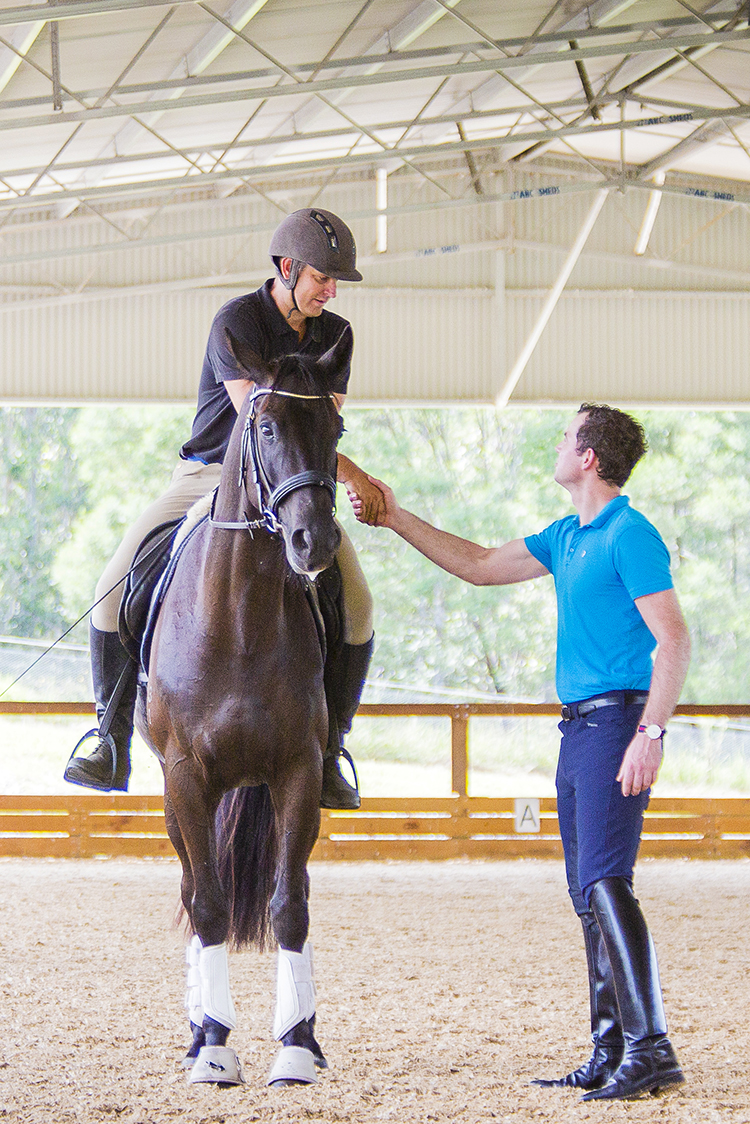
Does the public drive that then? If so, does there need to be more education?
“Partly of course. It’s very important for any trainer to be mentioned positively somewhere in the media. It really makes big difference if you are mentioned positively or negatively.”
Do you feel there’s becoming a bit of a division in dressage because of this though?
“No, I don’t think this is true. I think we are very sensitised, all of us. We also have to realise that there are some really good, sensible trainers out there and we should not overlook them. There are a lot of excellent trainers, really.”
“It is a problem, the bad training, it’s not a good thing, but I see it a little more relative. On the other hand I think horses are treated pretty well these days overall. Some of them live better than a lot of people. I’m just trying to see it from a distance and be realistic and objective about things and not be drawn into one of these insane discussions where you take one side or the other. I think clear analysis helps the best. Like with the lecture tonight, showing the photos not to judge someone for being a good or bad or mean rider, but just judging a moment as being good or not so good and differentiate it.”
Do you engage in alternative training with the horses?
“Yes, we have a gallop track at home, which they go at walk and I also ride them out there in a jumping saddle to get up off their back and canter them forward. They also do ground pole work but not a whole lot. I should do more! That’s about most of it. We so also have an eventing field. They are sometimes worked there as well, but the most part is the dressage work.”
Nine or ten horses from memory?
“We have 12 now.”
Any superstars in the making?
“Most of them I am training up as the business is only 18 months old. A few of the young ones, two five-year-olds, two six-year-olds, one that starts in Prix St George, I am hoping to get them out there this year. They were just not ready last year.”
Do you try to keep things pretty straight forward with the work; forward and back, a bit of laterals or do you like really trying to put every lateral movement choreographed in every possible way?
“Let’s just say a good half pass is the result of good bend, good impulsion and good balance. The horse crosses its legs to the inside because it’s bent, it puts its weight to the inside and pushes through forward to the bit. So, it is a movement that is the result of certain basics. Dressage movements are not there for their own purpose. They are there to check to give you feedback as to whether certain basics work, so we should not forget that dressage was invented so that we could survive in the battlefield.”
“And that’s kind of the idea. It’s just a check to see if it’s working and I really see it that way. Obviously when you go to a competition it has to work, but again, you get the result when you understand how to gymnasticise the horse properly. So, I don’t think you should start a half pass and hit all kinds of problems and then try and fix it. I ride a half pass when I think I am able to influence my horse’s balance and able to push it through. You get it or you don’t and you go back on your circle. Now that is also relative. Sometimes I will ride five half passes after each other and work the horse in the half pass. Once your horse does nice lateral work, it has a lot of benefits the other way around and shoots back on collection, impulsion and strength and dynamics over all. So when the horse is there and capable, I use the half pass to improve the next step. It’s not that I’m never riding a half pass, I’m just not going to start a half pass when I have to labour it over. There’s nothing uglier than a laboured half pass!”



